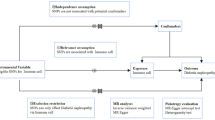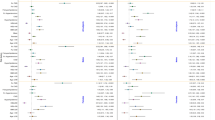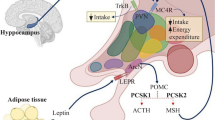Abstract
The aim of the study was to investigate the association between single nucleotide polymorphisms (SNPs), rs1861612 of delta/notch-like Epidermal Growth Factor (EGF)-related receptor (DNER) and rs1884190 in the Delta-like 1 ligand (DLL1) gene and type 2 diabetes mellitus (T2DM) susceptibility in a Chinese Han population. DNER rs1861612 and DLL1 rs1884190 polymorphisms were genotyped in patients with T2DM and age- and sex-matched T2DM-free controls from a Chinese Han population. A total of 298 patients with T2DM and 500 controls were enrolled in this study. We found that TC and TT genotypes of rs1861612 and variant T were associated with a significantly increased risk of T2DM. In contrast, the AG and AA genotypes of rs1884190 were not significantly associated with the risk of T2DM, even after further stratification analysis based on age or sex. Our results showed that DNER rs1861612 C to T change and variant T genotype may contribute to T2DM in a Chinese Han population.
Similar content being viewed by others
References
American Diabetes Association. (2014). Diagnosis and classification of diabetes mellitus. Diabetes Care, 37(Suppl 1), S81–S90.
American Diabetes Association. (2014). Standards of medical care in diabetes–2014. Diabetes Care, 37(Suppl 1), S14–S80.
O’Rahilly, S., Barroso, I., & Wareham, N. J. (2005). Genetic factors in type 2 diabetes: the end of the beginning? Science, 307(5708), 370–373.
Xu, Y., Wang, L., He, J., Bi, Y., Li, M., Wang, T., et al. (2013). Prevalence and control of diabetes in Chinese adults. JAMA, 310(9), 948–959. doi:10.1001/jama.2013.168118.
Browning, B. L., & Browning, S. R. (2008). Haplotypic analysis of Wellcome Trust Case Control Consortium data. Human Genetics, 123(3), 273–280.
Voight, B. F., Scott, L. J., Steinthorsdottir, V., Morris, A. P., Dina, C., & Welch, R. P. (2010). Twelve type 2 diabetes susceptibility loci identified through large-scale association analysis. Nature Genetics, 42(7), 579–589.
Huang, J., Ellinghaus, D., Franke, A., Howie, B., & Li, Y. (2012). 1000 Genomes-based imputation identifies novel and refined associations for the Wellcome Trust Case Control Consortium phase 1 Data. European Journal of Human Genetics, 20(7), 801–805.
Unoki, H., Takahashi, A., Kawaguchi, T., Hara, K., Horikoshi, M., & Andersen, G. (2008). SNPs in KCNQ1 are associated with susceptibility to type 2 diabetes in East Asian and European populations. Nature Genetics, 40(9), 1098–1102.
Cho, Y. S., Chen, C. H., Hu, C., Long, J., Ong, R. T., & Sim, X. (2012). Meta-analysis of genome-wide association studies identifies eight new loci for type 2 diabetes in east Asians. Nature Genetics, 44(1), 67–72.
Saxena, R., Saleheen, D., Been, L. F., Garavito, M. L., Braun, T., & Bjonnes, A. (2013). Genome-wide association study identifies a novel locus contributing to type 2 diabetes susceptibility in Sikhs of Punjabi origin from India. Diabetes, 62(5), 1746–1755.
Hanson, R. L., Bogardus, C., Duggan, D., Kobes, S., Knowlton, M., & Infante, A. M. (2007). A search for variants associated with young-onset type 2 diabetes in American Indians in a 100 K genotyping array. Diabetes, 56(12), 3045–3052.
Hanson, R. L., Muller, Y. L., Kobes, S., Guo, T., Bian, L., & Ossowski, V. (2014). A genome-wide association study in American Indians implicates DNER as a susceptibility locus for type 2 diabetes. Diabetes, 63(1), 369–376.
Eiraku, M., Hirata, Y., Takeshima, H., Hirano, T., & Kengaku, M. (2002). Delta/notch-like epidermal growth factor (EGF)-related receptor, a novel EGF-like repeat-containing protein targeted to dendrites of developing and adult central nervous system neurons. Journal of Biological Chemistry, 277(28), 25400–25407.
de Graaff, E., Maat, P., Hulsenboom, E., van den Berg, R., van den Bent, M., & Demmers, J. (2012). Identification of delta/notch-like epidermal growth factor-related receptor as the Tr antigen in paraneoplastic cerebellar degeneration. Annals of Neurology, 71(6), 815–824.
Min, X. H., Yu, T., Qing, Q., Yuan, Y. H., Zhong, W., Chen, G. C., et al. (2014). Abnormal differentiation of intestinal epithelium and intestinal barrier dysfunction in diabetic mice associated with depressed Notch/NICD transduction in Notch/Hes1 signal pathway. Cell Biology International, 38(10), 1194–1204.
Bar, Y., & Efrat, S. (2014). The NOTCH pathway in β-cell growth and differentiation. Vitamins and Hormones, 95, 391–405.
Valenti, L., Mendoza, R. M., Rametta, R., Maggioni, M., Kitajewski, C., Shawber, C. J., et al. (2013). Hepatic notch signaling correlates with insulin resistance and nonalcoholic fatty liver disease. Diabetes, 62(12), 4052–4062.
Mehrotra, S., Fakiola, M., Mishra, A., Sudarshan, M., Tiwary, P., & Rani, D. S. (2012). Genetic and functional evaluation of the role of DLL1 in susceptibility to visceral leishmaniasis in India. Infection, Genetics and Evolution, 12(6), 1195–1201.
Gavin III, J. R., Alberti, K. G. M. M., Davidson, M. B., & DeFronzo, R. A. (1997). Report of the Expert Committee on the Diagnosis and Classification of Diabetes Mellitus. Diabetes Care, 20(7), 1183–1197.
Malhotra, A., Kobes, S., Knowler, W. C., Baier, L. J., Bogardus, C., & Hanson, R. L. (2011). A genome-wide association study of BMI in American Indians. Obesity (Silver Spring), 19(10), 2102–2106.
Qiu, X. M., Jin, C. T., & Wang, W. (2014). Association between single nucleotide polymorphisms of sterol regulatory element binding protein-2 gene and risk of knee osteoarthritis in a Chinese Han population. Journal of International Medical Research, 42(2), 320–328.
Kim, I. M., Wolf, M. J., & Rockman, H. A. (2010). Gene deletion screen for cardiomyopathy in adult Drosophila identifies a new notch ligand. Circulation Research, 106(7), 1233–1243.
Fukazawa, N., Yokoyama, S., Eiraku, M., Kengaku, M., & Maeda, N. (2008). Receptor type protein tyrosine phosphatase zeta-pleiotrophin signaling controls endocytic trafficking of DNER that regulates neuritogenesis. Molecular and Cellular Biology, 28(14), 4494–4506.
Graus, F., Arino, H., & Dalmau, J. (2014). Paraneoplastic neurological syndromes in Hodgkin and non-Hodgkin lymphomas. Blood, 123(21), 3230–3238.
Hein, R., Flesch-Janys, D., Dahmen, N., Beckmann, L., Lindstrom, S., & Schoof, N. (2013). A genome-wide association study to identify genetic susceptibility loci that modify ductal and lobular postmenopausal breast cancer risk associated with menopausal hormone therapy use: a two-stage design with replication. Breast Cancer Research and Treatment, 138(2), 529–542.
Sun, P., Xia, S., Lal, B., Eberhart, C. G., Quinones-Hinojosa, A., & Maciaczyk, J. (2009). DNER, an epigenetically modulated gene, regulates glioblastoma-derived neurosphere cell differentiation and tumor propagation. Stem Cells, 27(7), 1473–1486.
Acknowledgments
This work was supported by Health Bureau of Zhejiang Province (No. 2013KYB286), Hangzhou Science and Technology Committee Research Project (No. 20130733Q10), Zhejiang Province Natural Science Foundation (LY14H040004), Medical Fund of Zhejiang Province (2013KYA207), and Shaoxing Science & Technology Bureau Program (2013B70079).
Author information
Authors and Affiliations
Corresponding author
Rights and permissions
About this article
Cite this article
Deng, Z., Shen, J., Ye, J. et al. Association Between Single Nucleotide Polymorphisms of Delta/Notch-like Epidermal Growth Factor (EGF)-Related Receptor (DNER) and Delta-like 1 Ligand (DLL 1) with the Risk of Type 2 Diabetes Mellitus in a Chinese Han Population. Cell Biochem Biophys 71, 331–335 (2015). https://doi.org/10.1007/s12013-014-0202-3
Published:
Issue Date:
DOI: https://doi.org/10.1007/s12013-014-0202-3




